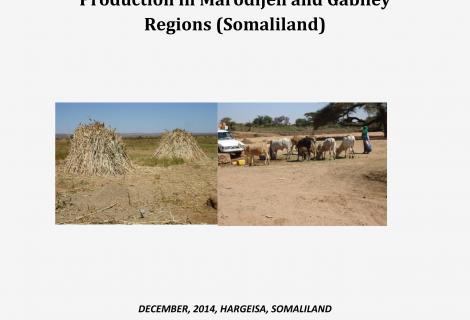
Impact of Climate Change on Agricultural Production in Marodijeh and Gabiley Regions in Somaliland
Executive summary
1. Marodijeh and Gabiley (M&G) regions of Somaliland together produce higher quantities of cereals and vegetables than the total of these commodities produced by other regions of the country. Gabiley region, in particular contributes much more significantly than Marodijeh region. In recent years, the impact of climate change on the agropastoral communities in Somaliland has been felt through unusual recurrence of droughts, frequent floods, appearance of invasive and exotic plant species, increasing land degradation, and declining crop and livestock productivity.
2. The IPCC Fifth Assessment report indicated an increase in temperature of 0.8-1°C has already been observed in East Africa (including Somalia, Somaliland) with projected increase of 2-3°C by 2065. The IPCC report also projected a 20 to 30% increase in precipitation for East Africa by 2065. However, any gains in rainfall may be offset through evaporation by increased temperatures.
3. This study aimed at analyzing and assessing the impact of climate change on agricultural production in agropasstoral areas of M&G regions.Fourteen villages were surveyed for individual house data, and in seven of these focus group discussions were held to obtained detailed information about livelihoods and impacts of climate change.
4. Livestock and crop production are the principal sources of livelihood for the agropastoral communities in the M&G regions. The mean numbers of small stock owned per household are 15, and 16 sheep and goats, respectively. Mean ownership of cattle and camels are 3 and 1.5 per household, respectively. Additionally, each household, on average keeps one donkey and 4 chickens. Each household cultivates, on average, less than 1.5 hectares each of sorghum, maize, and vegetables.The small herd size kept per household and the small area planted, clearly show that these communities have very low economic base, and are very vulnerable to any significant climatic or socioeconomic shocks.
5. Seventy-eight percent of household respondents considered that droughts have become more frequent, while 54% also considered that floods have been more frequent, during the last 20 years. Most household respondents believed that rainfall in their villages has decreased over the last two decades. Additionally, 72% of respondents believed that Gu, the main rainy season, has been starting later than normal during the last 20 years. A majority of respondents also thought that Gu rains have been ending earlier than normal for the last two decades.
This implies that most respondents consider that the main rainy season has shortened as a result of climate change. Long-term rainfall climate data to support these assessments are not available for Somaliland.A majority of household respondents stated that sorghum yield, milk production per lactating animal and fodder production per farm all decreased during the last twenty years. Additional impacts of climate change that was stressed by the focus groups included soil erosion and land degradation, decreased volumes of groundwater,and emergence of exotic, invasive weeds such as Partheniumhysterophorus, a serious weed that has spread to all farmland.
6. Overgrazing and deforestation, undoubtedly intensified during the last 20 years and contributed to lower fodder and pasture availability, as well as more soil fertility deterioration with subsequent negative impacts on livestock and crop production. Reduced groundwater levels have affected vegetable and fruit growers in the M&G by restricting the area they could cultivate and lowering yields. All focus groups mentioned that they have observed dropping groundwater levels in their villages. In addition to frequent droughts, this decline in groundwater volumes is also partially due to increased vegetable farms drawing larger water volumes from shallow wells in the ephemeral sand rivers. An increasing human population in these areas has also added greater demand for drinking water, which in the case of vegetable growing locations is sourced from shallow wells in the dry sand rivers.
7. The agropastoral communities in the M&G are particularly highly vulnerable to both climate change and climate variability. The vulnerability of these communities to climate change results from a combination and interactions among multiple factors including dependence on rainfed agriculture, low household incomes, lack of or only low education, poor infrastructure, lack of institutional capacity, poor communication of weather information and absence of planned adaptation strategies.
8. Adaptation strategies employed by these communities to minimize the negative impacts of climate change and climate variability include temporary relocation of livestock to other areas, storing grain harvests, storing sorghum and maize stover for animal feeding during the dry season, diversifying cultivated crops, reducing and/or changing the composition of livestock herds, sharing resources with relatives and neighbors, runoff water harvesting, engaging in casual labor, and migrating to urban areas to seek employment.
9. Somaliland lacks policies and strategies aimed at confronting the challenges imposed on agropastoral communities by climate change, and the country has not yet developed a NAPA (National Adaptation Program of Action). Unless planned adaptation programs are introduced and implemented the vulnerable agropastoral communities in the M&G will face greater food insecurity, conflicts over land and water, and greater migration of the youth.
10. Proposed recommendations include development of NAPA and mainstreaming climate change adaptation, introduction and promotion of drought tolerant and early maturing crop varieties, promotion of crop diversification, incorporation of legumes into the cropping systems, diversification of cultivated crops, development of soil and water conservation measures, development of water harvesting techniques, introduction of drought tolerant fodder species, and farmer training on good production practices.
Adan Elmi Abdullahi is the Author of the Report,